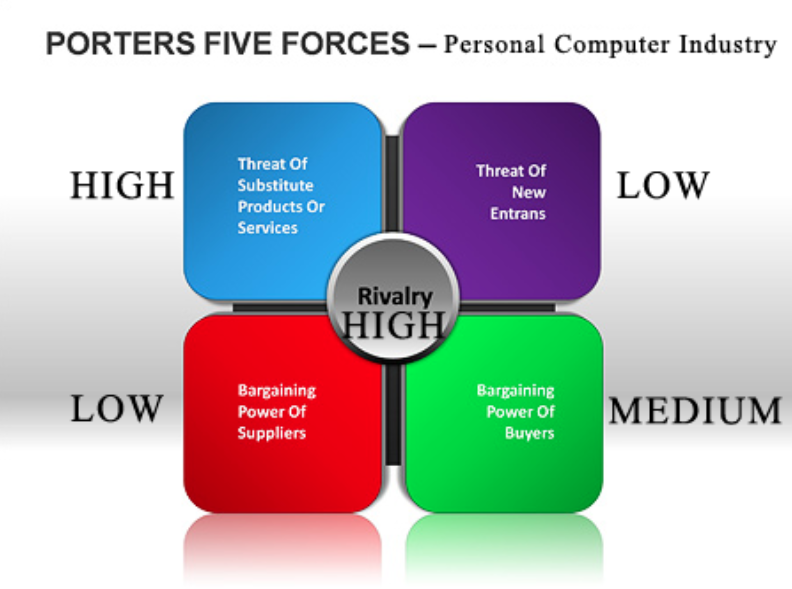Introduction
Apple Inc. has been outstanding over the years in the development of a distinct strategy of innovation in the industry. The strategy utilized by the company has presented it with the opportunity to become a leader in introducing new products that disrupt the market. Additionally, the company continuously improves its existing products. In an effort to satisfy the requirements of a global customer base, the company uses the differentiation strategy by offering inventive products (Isaacson 1).
The aim of writing this paper is to explore whether or not the current company management will uphold the success of the company considering the demise of the individual mainly identified with the success of the company, Steve Jobs. The paper explores the elements of Apple’s strategy, the company’s business model, the competition in the PC industry, the company’s competitive position, and the company’s future.
Identification of innovation strategy from the case
Since its founding in 1976, Apple has been successful in the computer and related technologies, and the electronics industry. Apparently, success is derived from the company’s business strategy. Primarily, the company uses innovative strategies to meet customer demands and remain ahead of the competition through market disruptions. After introducing Apple I, the company was already developing Apple II in 1977 with Macintosh under development to be released in 1984. Macintosh generated a stir in the market as a breakthrough in user-friendly computers. The company released its version of the personal digital assistant in 1993.
In 1994, the company launched the PowerMac computers. In 1997, Jobs launched the online Apple store, which was a success. By 1998, the company released the lower-end consumer computer, iMac, that became the best-selling computer in the US (Marino and Hattaway 147).
The company’s business model utilizes the differentiation strategy. The company introduces different products in addition to the computers that it initially targeted. These products are diversified from software to hardware to licenses (including the Apple Store Merchandise). They include personal computers, Mac laptops, iPods, and iTunes, OS X, and the innovative iPhone and iPad (Kane 3). The innovative, disruptive, and diversification strategies place the company ahead of its competitors.
Key issues and opportunities
The PC industry is highly competitive. The company’s computers are not competitive compared to others offered by competitors such as Dell and Hewlett-Packard. Despite the expansion of the PC market due to emerging markets with PC becoming a necessity in every home, Apple does not stand a considerable opportunity to flourish in the industry. There are many companies that are ahead of the company in terms of the PC market. The company synergizes by offering a wide range of other products to dilute the effect of competition on its revenue.

The Company’s distinctive aptitudes present it with a globally competitive advantage, predominantly in view of its capacity to construct platforms from a product base that incorporates practical and appealing designs. Apple has great opportunities in developing advanced versions of the iPhone and related products.
Diagnosis of competition issues
The PC industry is not inherently attractive to Apple. However, it is necessary as it contributes to the company’s revenues. However, the company requires continuing investing significantly in its research and design. The approach will enable the company to have an innovative product ready for the market whenever competitors introduce a new product into the market. The strategy will facilitate the company to disrupt the market continuously and will keep the competitors guessing about its next strategic move (Peteraf, and Strickland 10).
Analysis and Evaluation
The PC industry is highly competitive, considering that dominant companies are financially endowed. In this regard, Apple ought to continue with the identified strategy of innovation, disruption, and diversification. Evidently, the company gets revenue from a wide range of its products. The iPhone launched in 2007 took 74 days to click the one million units in sales while it took only 3 days for the iPhone 3G to hit the same level. All the company’s divisions indicate significant sales except the PC division. The trend in company sales indicates that the company is successful in other divisions, including the App Store and iTunes.
Options
Apple Inc. may opt to expand its PC market through the acquisition of leading PC companies. However, these companies should be innovation-oriented to bring technology into the company’s portfolio.
Recommendation and Conclusion
Apple has the option of exploring emerging markets with its innovative products. In these markets, it should introduce lower-end products for the consumers while ensuring the quality of these products. In the existing markets, the company should ensure that the products are ahead of competitors in terms of innovativeness. The market disruption introduced by Jobs should remain a strategy for the company to overcome the cutthroat competition.
A brief plan of action
It is imperative for the management to realize the risks and threats lying head of the company business due to new entrants and intense rivalry with the current competitors. The company should hence review its marketing strategy to ensure vigorous marketing of its products. It should also endeavor to create a loyal customer base for its products. Additionally, the company should ensure it develops PCs that are on par with emerging technologies to gain competitive advantage.
Works Cited
Isaacson, Walter. “The Real Leadership Lessons of Steve Jobs.” Harvard Business 1.1 (2012): 1-7. Print.
Kane, Yukari. “Jobs Quits as Apple CEO.” The Wall Street Journal 1.1 (2011): 1-4. Print.
Marino, Lou and John Hattaway. “Apple Inc in 2008.” Cases in Crafting and Executing Strategy 1.2 (2008): 145-161. Print.
Peteraf, Thompson and Strickland Gamble. Crafting and Executing Strategy, Concepts and Cases, New York, NY: McGraw-Hill Irwin. 2012. Print.